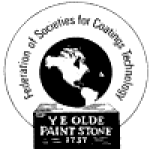- Industry: Paints & varnishes
- Number of terms: 70
- Number of blossaries: 0
- Company Profile:
Represents chemists, chemical engineers, technologists, and supervisory production personnel in the decorative and protective coatings industry and allied industries.
(1) General term applied to a wide variety of more or less transparent and fusible products, which may be natural or synthetic. They may vary widely in color. Higher molecular weight synthetic resins are generally referred to as polymers. (2) A solid, semi-solid, or pseudo-solid organic material that has an indefinite and often high molecular weight, exhibits a tendency to flow when subjected to stress, usually has a softening or melting range, and usually fractures conchoidally. (3) In a broader sense, the term is used to designate any polymer that is a basic material for coatings and plastics.
Industry:
Any one of a large family of substances chiefly used with titanium dioxide, the primary pigment, as an extender pigment. When used in moderation, these silicates (magnesium silicate, aluminum silicate, etc.) are valuable in helping control gloss, aid brushability, and increase hold-out properties and overall exterior durability.
Industry:
Contracted from surface-active agents, these are additives which reduce surface tension and thereby improve wetting (wetting agents), help disperse pigments, inhibit foam, or emulsify. Conventionally, they are classified as to their charge: anionic (negative); cationic (positive); nonionic (no charge); or amphoteric (both positive and negative).
Industry:
The thinner and binder together form the paint's vehicle. Water, the thinner used in latex paints, evaporates as the paint dries, allowing a smooth paint application. Turpentine or spirits are the thinners in oil-based paints.
Industry:
Adjective which describes full-bodied material which undergoes a reduction in viscosity when shaken, stirred, or otherwise mechanically disturbed and which readily recovers the full-bodied condition on standing.
Industry:
A high opacity, bright white pigment of the chalking type, used as a prime pigment in paints, rubber, plastics. Prepared from the mineral ilmenite, or rutile ore.
Industry:
A high opacity, bright white pigment of the non-chalking type, used as a prime pigment in paints, rubber, plastics. Prepared from the mineral ilmenite, or rutile ore.
Industry:
The liquid portion of the paint, in which the pigment is dispersed; it is composed of a binder and a thinner.
Industry:
(1) The unsaturated, univalent radical CH2: CH -- derived from ethylene. (2) Any of the various compounds containing this group, typically highly reactive, easily polymerized and used as a basic material for coatings and plastics. (3) Any of the various plastics, typically tough and flexible.
Industry:
